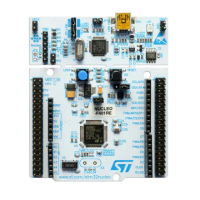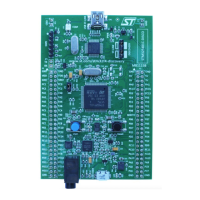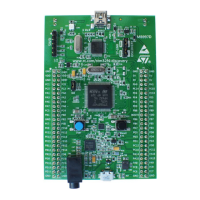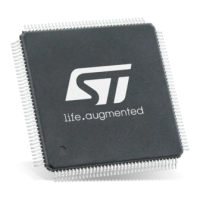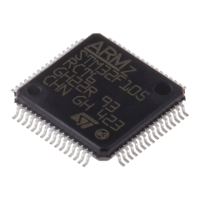RM0402 Rev 6 295/1163
RM0402 Quad-SPI interface (QUADSPI)
316
is set when the limit of the external SPI memory is reached according to the Flash memory
size defined in the QUADSPI_CR.
Triggering the start of a command
Essentially, a command starts as soon as firmware gives the last information that is
necessary for this command. Depending on the QUADSPI configuration, there are three
different ways to trigger the start of a command in indirect mode. The commands starts
immediately after:
1. a write is performed to INSTRUCTION[7:0] (QUADSPI_CCR), if no address is
necessary (when ADMODE
= 00) and if no data needs to be provided by the firmware
(when FMODE
= 01 or DMODE = 00)
2. a write is performed to ADDRESS[31:0] (QUADSPI_AR), if an address is necessary
(when ADMODE
!= 00) and if no data needs to be provided by the firmware (when
FMODE
= 01 or DMODE = 00)
3. a write is performed to DATA[31:0] (QUADSPI_DR), if an address is necessary (when
ADMODE
!= 00) and if data needs to be provided by the firmware (when FMODE = 00
and DMODE
!= 00)
Writes to the alternate byte register (QUADSPI_ABR) never trigger the communication start.
If alternate bytes are required, they must be programmed before.
As soon as a command is started, the BUSY bit (bit 5 of QUADSPI_SR) is automatically set.
FIFO and data management
In indirect mode, data go through a 32-byte FIFO which is internal to the QUADSPI.
FLEVEL[5:0] (QUADSPI_SR[13:8]) indicates how many bytes are currently being held in
the FIFO.
In indirect write mode (FMODE = 00), firmware adds data to the FIFO when it writes
QUADSPI_DR. Word writes add 4 bytes to the FIFO, halfword writes add 2 bytes, and byte
writes add only 1 byte. If firmware adds too many bytes to the FIFO (more than is indicated
by DL[31:0]), the extra bytes are flushed from the FIFO at the end of the write operation
(when TCF is set).
Byte/halfword accesses to QUADSPI_DR must be done only to the least significant
byte/halfword of the 32-bit register.
FTHRES[3:0] is used to define a FIFO threshold. When the threshold is reached, the FTF
(FIFO threshold flag) is set. In indirect read mode, FTF is set when the number of valid
bytes to be read from the FIFO is above the threshold. FTF is also set if there are data in the
FIFO after the last byte is read from the Flash memory, regardless of the FTHRES setting.
In indirect write mode, FTF is set when the number of empty bytes in the FIFO is above the
threshold.
If FTIE = 1, there is an interrupt when FTF is set. If DMAEN = 1, a DMA transfer is initiated
when FTF is set. FTF is cleared by HW as soon as the threshold condition is no longer true
(after enough data is transferred by the CPU or DMA).
In indirect read mode when the FIFO becomes full, the QUADSPI temporarily stops reading
bytes from the Flash memory to avoid an overrun. Note that the reading of the Flash
memory does not restart until 4 bytes become vacant in the FIFO (when FLEVEL
≤ 11).
Thus, when FTHRES
≥ 13, the application must take care to read enough bytes to assure
that the QUADSPI starts retrieving data from the Flash memory again. Otherwise, the FTF
flag stays at '0' as long as 11
< FLEVEL < FTHRES.
